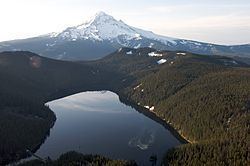Basin countries United States Surface elevation 967 m Mean depth 20 m Width 800 m | Primary inflows Catchment area 3.5 sq mi (9.1 km) Max. length 1.5 mi (2.4 km) Area 189 ha Length 2.4 km Outflow location Bull Run River | |
 | ||
Bull Run Lake is a reservoir, an impoundment of the Bull Run River in the U.S. state of Oregon. Providing part of the primary drinking water supply for Portland, Oregon, it rates highly as an oligotrophic lake, a very clean source of water.
Map of Bull Run Lake, Oregon 97049, USA
The lake basin receives more than 110 inches (2,800 mm) of rain annually due to its location in the Cascade Range, about 9 miles (14 km) west of Mount Hood. Public access to the area has been controlled since June 17, 1892, with the creation of the Bull Run Reserve by President Benjamin Harrison. Water from the reservoir first flowed into the Portland water system on January 2, 1895. President Theodore Roosevelt restricted entry to all but government agents and water company employees and banned stock grazing on April 28, 1904.
In 1915 a new timber and rock fill dam raised the lake level about 10 feet (3.0 m). At least two series of efforts were made between 1917 and 1925 to decrease lake seepage. In 1961 additional areas of seepage were sealed with clay, and the outlet dam was remodeled to contain gates at elevations of 3,147 feet (959 m) and 3,158 feet (963 m).
In 1994, concerns of outflow water temperature and its effect on fish populations led to regular careful measurements of the lake's thermocline characteristics and the inlet water temperature. Concrete pier blocks were installed to minimize the effect of water temperature shock on downstream aquatic life.
